|
|
 |
The pitchpipes (lülü 律呂)
Most fundamental for Chinese music theory is the system of the twelve pitchpipes (shi'er lü 十二律) that is composed of a scale of twelve pipes (lülü 律呂). The term lǜ 律 means "measure", and is later also applied to "judicial measures" of the administrative law (like lüli 律例 "laws and precedent cases", or the modern term falü 法律 "law"); the term lǚ 呂 means "XXX". One of the oldest definition of the term lǜ 律 is to be found in the history Guoyu 國語, where the music master Ling Zhoujiu 伶州鳩 explained that lü means something with the help of which standards for measurements are created (suoyi li jun chu du 所以立均出度). These are based on one fundamental unit, from which all other measurements are derived, like the bones of a spine (which is the actual meaning of the world lü 呂). Six of the pipes were called lǜ (liùlǜ 六律), the others lǚ (liùlǚ 六呂). Music Master Zhoujiu discerned between odd-number pipes (danshu 單數) and even-number pipes (shuangshu 雙數) or "intermediate pipes" (liu jian 六間). These were later called the six yang pipes (liu yanglü 六陽律) and the six yin pipes (liu yinlü 六陰呂; see Yin and Yang). Although there is an explanation given for the meaning of the word lǜ 律, the real origin of this designation, as well as that of the lǚ 呂 pipes, is shrouded in mystery.
The earliest system of the pitchpipes is called "pure intonation" (chunlü 純律). The length of all pipes in this system are derived from the Yellow Bell pipe (huangzhong 黃鐘). By alternatively substracting a third and adding a third of the length of the pipe, the higher tones of the scale are created. This method makes it necessary that the diameter and the circumference of each pipe is the same. According to legend, the system was invented by a certain Ling Lun 伶倫, a minister of the Yellow Emperor 黃帝. When he heard the cries of phoenixes in the vales of Mt. Kunlun 崑崙 the idea came to him to use these sounds to create a tempered musical system. The Yellow Emperor ordered him to cast twelve bells (zhong 鍾). In fact, bells are the oldest music instruments that give evidence of the pentatonic system used in China, and the names of the height of these tones. The oldest surviving bronze bells are inscribed with words like tuobin 妥賓 (later called ruibin 蕤賓) or wutai XXX 無旲 (corresponding to the later wuyi 無射).
The height of the twelve tones depends on that of the basic tone of the Yellow Bell pipe. Yet the problem of this system is that the absolute height of this tone was not fixed anyhow, and therefore also those of the other pipes whose tone was always related to that of the basic tone. The "pure tone" of each pipe was seen as a "correct" tone (zhenglü 正律), meaning a full tone in the sense of the Western musical system. For some music instruments, especially the zither, reduced of half-tones were made use of. These were called "altered tones" (bianlü 變律) and are also to be found in many musical modes (gongdiao 宮調) of theatre airs.
The term "six lǜ pipes" 六律 is first to be found in the Confucian Classic Zhouli 周禮, which was finalized during the Han period 漢 (206 BCE-220 CE). Older texts like the Guoyu (with Shi Bo's 史伯 discussion on music) or the history Zuozhuan 左傳 speak of five or six tones, and not of six pipes. Similarly, the oldest traces of the "intermediate tones" (jianyin 間音) in the inscriptions on the bells found in the Warring States 戰國 (5th cent.-221 BCE) period tomb of Marquis Zeng 曾侯乙, refer to altered tones, and not to the six lǚ 六呂 pipes. The chapter Chunguan 春官 "Spring offices" in the Classic Zhouli includes a third term, namely "six equals" (liutong 六同), in the phrase zhang liulü liutong zhi he 掌六律六同之和 "XXX controls the harmony of the six lǜ pipes and the six equals". Some commentators interprete the character 同 as a clerical error for 間, others for a homophone of tong 銅 "bronze (pipes or tubes)". The Qing period 清 (1644-1911) scholar Ji Dakui 紀大奎 finally concluded that the "six equals" might be another series of tones that included only altered tones (bianlü).
Source. Huang Xiangpeng 黃翔鵬 (XXX). "Lülü 律呂", in: 中國大百科全書 音樂 舞蹈》 第402頁
The chapter on measures and the calendar (Lüli zhi 律曆志) in the history Hanshu 漢書 is one of the oldest surviving descriptions of the measures of the pitchpipes. Other sources are the books Guanzi 管子, Lüshi chunqiu 呂氏春秋 (part Jixia ji 季夏紀) and the chapter Tianwen xun 天文訓 in the Daoist book Huainanzi 淮南子. The chapter on the pitchpipes (Lü shu 律書) in the history Shiji 史記 is corrupted and is practically useless in respect to mathematical exactness. The Hanshu explains that Ling Lun 泠綸 (other characters for 伶倫) used bamboo tubes to produce the twelve pipes, six of which represented the voice of the male phoenix, and six that of the female bird. Six is the central yin number, and therefore reigns the number of the pipes, while five is the central yang number and also that of the five tones in the pentatonic scale. Also under the influence of cosmologic concepts popular during that time, the method of creating the next pipe by subtracting and adding a third of the foregoing pipe was invented. Three was seen as the number of Heaven, two as that of the Earth.
From the length of the Huangzhong pipe 黃鐘 (idealter 9 cun "inches") one third is subtracted, resulting in the 6 cun long Linzhong pipe 林鐘. To the length of the Lingzhong pipe, one third is added, resulting in the 8 cun long Taicu pipe 太族. When subtracting one third again, the 5 1/3 cun long Nanlü pipe results 南呂. Adding one third again results in the 7 1/9 cun long Guxian pipe 姑洗. Subtracting a third will produce the 4 20/27 cun long Yingzhong pipe 應鐘, and so on.
| pipe |
length
(in cun, 1 cun = approx. 1 inch) |
corresponding month |
| six lǜ pipes 六律 |
| 黃鐘 Huangzhong |
9 |
9 |
11 |
| 太族 Taicu |
8 |
1 |
1 |
| 姑洗 Guxian |
7 1/9 |
7.111 |
3 |
| 蕤賓 Ruibin |
6 26/81 |
6.321 |
5 |
| 夷則 Yize |
5 451/729 |
5.619 |
7 |
| 亡射 Wuyi |
4 6524/6561 |
4.994 |
9 |
| six lǚ pipes 六呂 |
| 林鐘 Linzhong |
6 |
6 |
6 |
| 南呂 Nanlü |
5 1/3 |
5.333 |
8 |
| 應鐘 Yingzhong |
4 20/27 |
4.741 |
10 |
| 大呂 Dalü |
4 52/243 |
4.214 |
12 |
| 夾鐘 Jiazhong |
3 1631/2187 |
3.746 |
2 |
| 中呂 Zhonglü |
3 6487/19683 |
3.330 |
4 |
| Dimensions of the Twelve Pitchpipes according to the chapter Lüli zhi 律曆志 in the history Hanshu 漢書. |
Keys and Tuning
five tones 聲者,宮、商、角、徵、羽也。
角 jué,觸也,物觸地而出,戴芒角也。wood, spring
徵 zhi3,祉也,物盛大而祉也。fire, sommer
宮,中也,居中央,暢四方,唱始施生,為四聲綱也。center
商之為言章也,物成孰可章度也。metal, autumn
羽,宇也,物聚臧宇覆之也。water, winter
Music Instruments
Traditional Chinese music knowns the eight sound colours (bayin 八音), namely earth (tu 土, represented by the ocarina xun 塤), gourd (pao 匏, mouth organ sheng 笙), leather (pi 皮, drums gu 鼓), bamboo (zhu 竹, flutes guan 管), silk (si 絲, chordophones xian 絃), stone (shi 石, chimes qing 磬), metal (jin 金, bells zhong 鐘), and wood (mu 木, represented by the scraper zhu 柷).
Historically, wooden and earthen instruments were of course the first music instruments in China, like elsewhere in the world too. The high standard of bronze casting during the Shang and Zhou periods was also adapted to create different kinds of bronze bells. Sounding stones, pending on a rack, were also popular during the Zhou Dynasty, used for official ritual events, like the big drums. Some drums were even totally made of bronze, equal to the famous bronze drums of Northern Vietnam. Flutes of different materials must have existed from the earliest times. A Chinese speciality are the few music instruments made of a gourd. But the most famous Chinese instruments did not originate in China. Many plucked and bowed string instruments came from the West, from Arabia or Inner Asia. Only bronze bells, sounding stones and drums were allowed during the ritual performances. All other instruments are used for daily entertainment, either at the court or among the people. Since the 20th century, many Western instruments (piano gangqin 鋼琴 "iron lute", violin xiaotiqin 小提琴 "lifted lute", guitar jita 吉他 - or translated as "six string lute" liuxianqin 六弦秦) came to China and are very popular to perform classical or pop music.
1 Bamboo instruments
The most important bamboo instruments are the flute xiao 簫 , also in the shape of a cluster of 16 to 20 pipes, bound together in a row, the flutes di 笛 and yue 龠, and the traverse flute chi 箎. , also in the shape of a cluster of 16 to 20 pipes, bound together in a row, the flutes di 笛 and yue 龠, and the traverse flute chi 箎.
2 Wooden instruments
Most wooden instruments are idiophones, sounding by themselves, like wooden drums, clappers (ban 板) or rattles (yu 敔). Buddhist monks use to clap their muyu 木魚 "Wooden fishes", hollowed out wooden globe of different seizes, during the sutra recitation.
There are only two woodwind instruments in China, and both are only employed during festivals among the people, never at the court. The first is the suona 嗩吶, a kind of simple oboe with a metal bell at the top. The second is called guan 管 and is also a primitive kind of oboe, but quite short and without bell. Both are probably not of Chinese origin (the suona is definitely borrowed from the Turkish zurna).
|
 |
 |
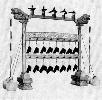 |
 |
 |
 |
| Xiao |
Muyu |
Suona and Guan |
Bianqing |
Sheng |
Morinchuur |
Bone trumpet |
3 Silk instruments
The strings of these instruments are made of silk, not of hair or gut like in the West, so that we must assume that at least a part of these music instruments originated in China. Especially the zithers qin 琴 (qin is also a general word for string instruments), se 瑟 and zheng 箏, are of Chinese origin, and there are many proofs for their existence in early Zhou China. Mythical tales explain the origin of these instruments as inventions of the Yellow Emperor or of his ministers. The huge long zheng or guzheng 古箏 zither, comprising 20 to 25 strings, is still very popular today and was transmitted to Japan as koto and to Korea as Kayagum (although the proud
Koreans state that it is a native invention of the state of Kaya). The word qin serves to describe all different kinds of zithers, like the trapeziform dulcimer yangqin 洋琴, that came to China from Persia probably during the Tang Dynasty. The lutes came to China already during the Han Dynasty, but especially during the time of north-south division when the cultural and economical relations with the Inner Asian people were very intense. One of the first string instruments coming to China from the West was the lute pipa 琵琶 (see the history of the pipa in the encyclopedia Tongzhi). Its smaller brother is the liuqin 柳琴 "willow lute
", and there is a cousin named "moon guitar" yueqin 月琴. These lutes are not handled like in the West, but are held vertically on the knees. The pipa was even traded to Japan with the name biwa, and there is a late Yuan theatre play named "The Lute" (Pipaji 琵琶記) . The pipa lute is quite similar to the Western lute, but it has only four strings and a very flat corpus. The moon guitar has a big round resonance body - hence its name - and a short neck, stabilizing three to four strings. The resonance body is flat at the back. A bigger type of this lute or guitar is the ruanxian 阮弦, with a resonance body that is also flat like that of the yueqin, but deeper, and it is the only Chinese string instrument with holes in the resonance corpus. Both pipa and yueqin resonance bodies show no holes like the Western violins, lutes or guitars.
A different type of plucked string instrument is the long neck guitar sanxian 三弦 with three strings (that is also just its name) and a very small resonance body, often covered with a snake skin. Its Japanese counterpart is the shamisen 三味線.
The most popular bowed string music instrument or fiddle is the erhu 二胡 with two strings. It is very similar to the sanxian and has an extremely small corpus, similar to a little drum with a leather resonator. The thin and long neck ends in two pegs that are standing seriell, not obstinate. There is also a four string type of this fiddle with two parallel resonance strings. The sanxian and erhu are instruments employed by professional musicians and storytellers on the street, and in the Chinese opera.
 |
 |
 |
 |
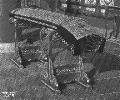 |
| Pipa |
Yueqin |
Sanxian |
Erhu |
Se, similar: Zheng |
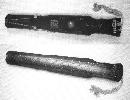 |
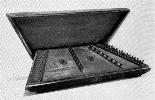 |
| Qin |
Yangqin |
4 Earthen instruments
The only earthen music instrument is a kind of ocarina called xun ˴.
5 Metal instruments
The group of these instruments comprises all different kinds of bells from the Zhou Dynasty. Most of them were pending from a rack and organized as chimes (bianzhong 編鍾). They were an integral part of Zhou ritual music. There were the types of zhong 鍾 (the regular word for "bell"), fu 鎛, chunyu ëÞ¤_, nao 鐃, and some others with only minimal differences to each other. In recent years, some bronze bell sets have been excavated from Warring States tombs and were reconstructed and reemployed in official performances. Bells were also used during the war, like trumpets in the West, to indicate attacks, redrawal, and other formations.
Gongs (round, or in the shape of a cloud), gong chimes and cymbals (yunluo 雲羅) have also be mentioned here. They are instruments of war, of popular festivals, or are used for an opera orchestra.
A metalwind instrument not yet mentioned is the laba 喇叭, a kind of trombone used during festivals and probably introduced from Inner Asia or Tibet, where the monasteries still today employ huge, some ten to fifteen feet long trombones to announce Buddhist festivals.
During the Zhou Dynasty, bronze drums were casted especially in the southern regions.
 |
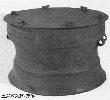 |
 |
 |
 |
| Bronze drum |
Bronze drum |
Zhong |
Chunyu |
Nao |
6 Stone instruments
In the West, stone instruments are unknown. Sounding stones qing 磬, pending from a rack and each stone with a different tone, are a native Chinese invention (the whole rack is called bianqing 編磬). The stones have a special shape, best described as rectangular and bend short before the middle, in a sharp angle, but not up to 90 degrees like the letter "L". The stones are hung up at the tip of the angle.
7 Leather instruments
There exist dozens of types of drums gu 鼓, from small handy drums to such types bound to the hip and clapped with two hands, to the huge drums that are drummed with a long stick, or with two sticks. Like many Chinese instruments, also the big drum was transmitted to Japan and Korea as taiko 大鼓
where it is played during some festivals.
8 Gourd instruments
There is actually no reason to classify the "mouth-organ" sheng 笙 as an instrument made of a gourd, although the first types of this music instrument obviously used a gourd as resonance corpus. The ball-like bottom of the sheng is held with both hands, just before the face. Blowing into a tube, the breath makes swinging some tongues made of bamboo (or metal, in the modern version). Out of the half-ball bottom, up to 36 reeds of different length and tonal height come out vertically. It is necessary to cover a hole on a reed to make it sounding. A smaller type of this instrument is called yu ¬ò, that looks like an upside down pan-flute. Both instruments are not Chinese, but they come from the southwestern hill tribes. Similar instruments are in use among the hill tribes in Laos, Thailand and Myanmar.
The most famous music instruments of the national minorities in China are probably the Mongol horse head fiddle (Morinchuur), the huge Tibetan bronze trumpets, and the Tibetian bone trumpets, made of human femur bones.
|
|
|

